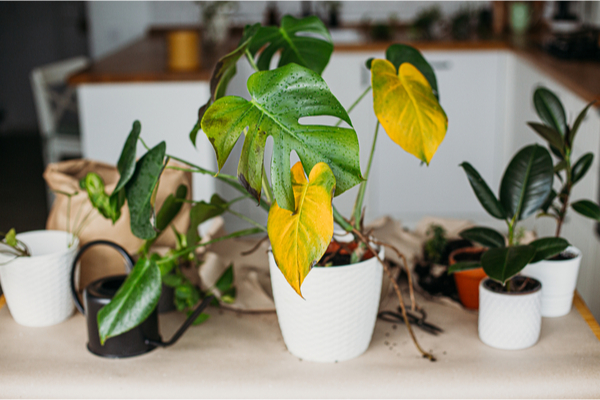One of the toughest aspects of being a plant parent is that our beloved ferns and philodendrons can’t talk to us to tell us what they need. We’re left guessing: Are they under-watered or drowning? Are they desperate for sun or craving some shade? Houseplants don’t have language, but they do have their own way of communicating what they need. Once you know the common signs—yellow leaves, leggy stems, few flowers—you’ll get better at guessing how your houseplant is feeling. Here are some classic signs that your houseplant isn’t very happy, plus how to help it thrive.
Getting “Leggy”
A “leggy” houseplant is one that’s grown tall and spindly, potentially even causing it to flop over. If your plant is unusual tall, looks uneven, or appears in need of a haircut, you may have a leggy houseplant on your hands.
The fix: Give it more sunlight. Plants tend to get spindly when they’re desperate for nutrients, causing them to grow taller as they reach for more sun. If that doesn’t do the trick, make sure the plant has nutrient-rich soil and fertilize it regularly during the growing season from spring to fall (but cut back on fertilizer during the winter).
Few (or No) Flowers
If you have a flowering plant that’s grown to full maturity but just never seems to bloom, it may be time to reevaluate its routine.
The fix: First, check if your plant has plenty of foliage but few flowers. This could be a sign of a nitrogen imbalance. Cut back on the nitrogen fertilizer and stick to a schedule (typically once per month) during the growing season. If the plant has sparse greenery and few blooms, your plant may need more sunlight. Remember, most flowering houseplants do best when you deadhead spent blooms, or remove any flowers that have died or dried up. Carefully removing the faded blooms leaves more room for fresh growth.
Yellow Leaves
I’m all too familiar with this sign of distress in my own houseplants. I’ll neglect them, feel guilty, and try to make it up to them with a generous amount of water. Then come the yellow leaves—a common signal that your houseplant may be overwatered or experiencing root rot.
The fix: Find a consistent watering schedule that works, then stick to it! Before watering, it’s always a good idea to test the soil moisture by sticking a finger about one to two inches down into the soil to test the moisture below the surface (the very top of the soil will dry out quickly and may be an unreliable indicator). Many easy-to-care-for houseplants are happy with a once per week watering routine. While you’re at it, make sure the pot or planter has adequate drainage and place a saucer underneath to catch overflow.
Scorched Leaves
If the leaves of your houseplant look brown and crispy on the edges, your plant may be suffering from sunburn. This is especially common in tropical plants, like monstera, which love sun but hate low humidity.
The fix: First, move the plant out of direct sun, then make sure it is getting enough water. If the room has very low humidity, consider misting the area around the plant more often or introducing a humidifier to boost the moisture in the air.
Drooping
Sometimes, your plant will tell you it’s not happy by looking, well, a little sad. Your once-perky plant suddenly has dry-looking leaves drooping down toward the floor. Fortunately, this is generally easy to fix.
The fix: Drooping or wilting is often a sign of drought, so a thorough watering should hopefully revive your parched houseplant. To test, stick a finger one to two inches into the soil to see if it’s dry. Remember, you may need to adjust your watering schedule in the summer if the inside of your home is warmer and causing the water to evaporate more quickly. Just avoid overcompensating by overwatering.
Brown and Crispy Leaves
It’s common for a healthy plant to get a couple brown leaves every now and then, but if your houseplant has many dry, brown leaves, it’s a sign of distress.
The fix: Most often, this is simply a sign your plant needs more moisture. Try watering it more frequently or introducing more humidity into the air by spritzing it or switching on a humidifier. If just the edges of the leaves are getting brown (and you’ve already ruled out sunburn, details above), it could mean you’re using too much fertilizer and need to cut back.
—
Photo Credit: Switlana Sonyashna / Shutterstock.com
